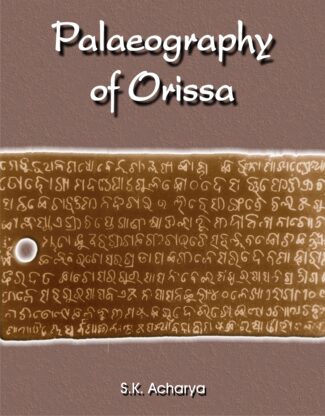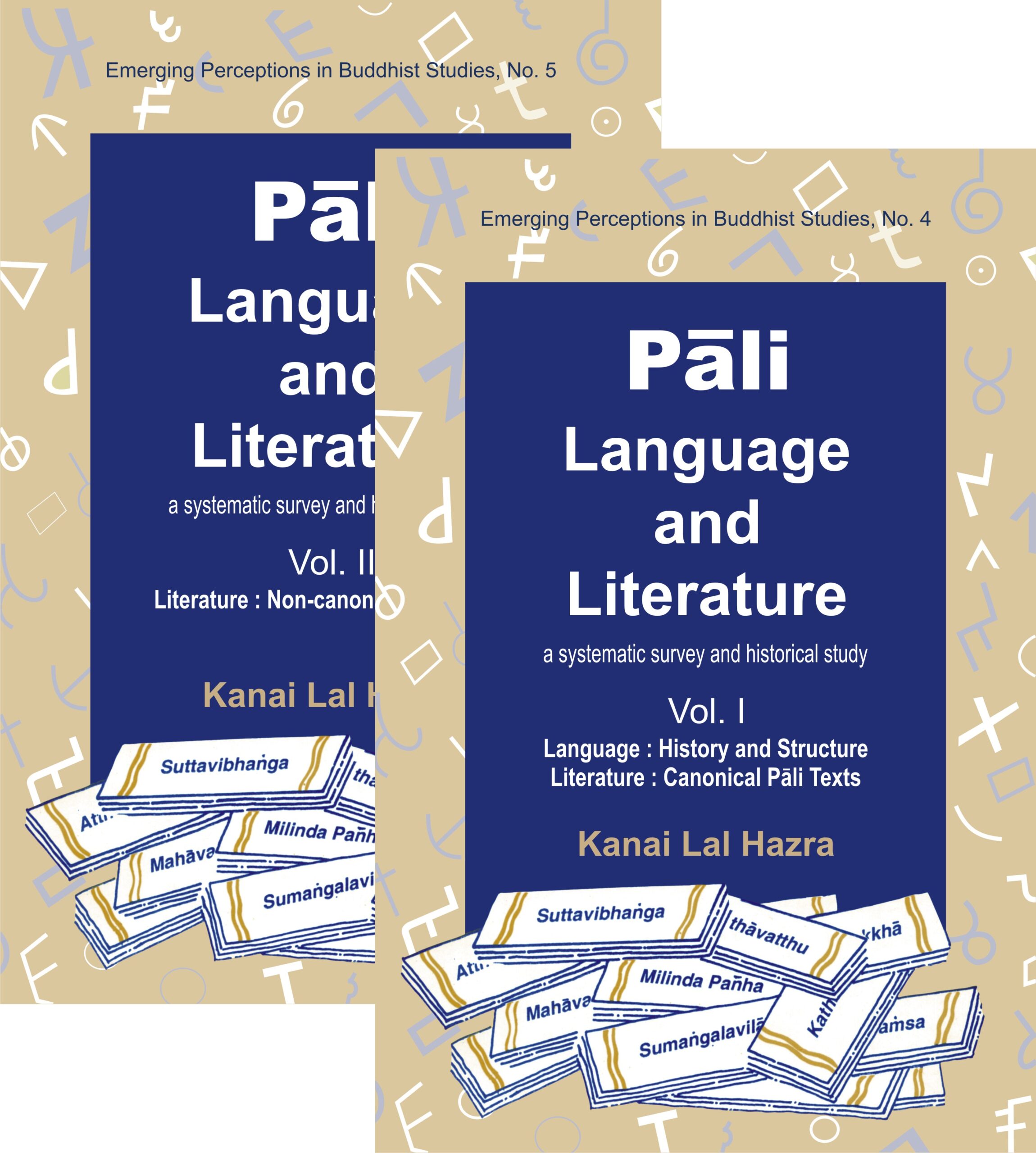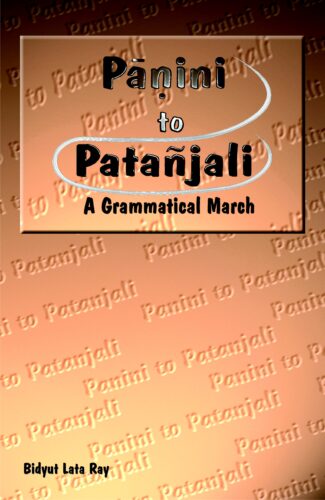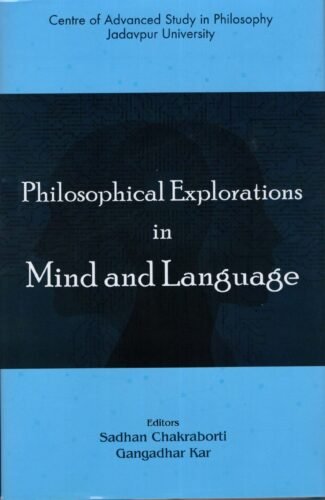Showing 13–24 of 62 results

This volume delves upon the Vakyapadiya of Bhartrhari, written in fifth century ce, as a contnuity of the theory and praxis of Panini and Patanjali on Sanskrit grammar and Indian language philosophy. It makes an attempt to explore and analyse some issues such as meaning of language, theory of sphota, and conditions and context of meaning.
The study of grammar and linguistic philosophy had its origin in the Vedic period, at least in the second millennium bce. The Vakyapadiya of Bhartrhari, an authoritative Sanskrit text written in the fifth century ce, contains reflections on the subject matter of language and grammar, thus the philosophy of language. Interpretation of communication is one of the principal objectives of Bhrtrhari’s philosophy of language. His goal is to interpret the communication of all living things, be it a man or an animal, or a yogi or a baby.
Bhartrhari represents a rich tradition of Indian philosophy of language that he inherited from Panini and Patanjali. The West, for all practical purposes, lagged behind in grammar, literary theories, philosophy of language and with the problems of meaning, even at the dawn of the twentieth century, when the Indian Grammarians made penetrating studies on the same even before the common era.
This volume delves upon “meaning” discussed in the Vakyapadiya as a continuity of the great Indian literary tradition, philosophy and grammar. In the process, it explores and analyses some issues such as meaning in Indian philosophy of language, theory of sphota, and conditions and context of meaning.
The study of grammar and linguistic philosophy had its origin in the Vedic period, at least in the second millennium BCE. The Vakyapadiya of Bhartrhari, an authoritative Sanskrit text written in the fifth century CE, contains reflections on the subject matter of language and grammar, thus the philosophy of language. Interpretation of communication is one of the principal objectives of Bhrtrhari’s philosophy of language. His goal is to interpret the communication of all living things, be it a man or an animal, or a yogi or a baby. Bhartrhari represents a rich tradition of Indian philosophy of language that he inherited from Panini and Patatijali. The West, for all practical purposes, lagged behind in grammar, literary theories, philosophy of language and with the problems of meaning, even at the dawn of the twentieth century, when the Indian Grammarians made penetrating studies on the same even before the common era.

The present book is a heavily annotated translation of the Namartha-nirnaya section of Kaundabhatta’s Vaiyakarana-bhushana, with an extensive introduction. While there are several books that discuss Indian semantic theories in general terms, this book belongs to a small class of intensive, focused studies of densely written philosophical texts which examine each argument in its historical and philosophical context. It is of interest to all students of philosophy of language in general, and to students of Indian philosophy in particular.
Kaundabhatta’s Vaiyakarana-bhushana is a massive work on semantic theory written in India in the 17th century. Kaundabhatta belonged to the tradition of Sanskrit grammar and in this work he consolidated the philosophy of language developed in the Paninian tradition of Sanskrit grammar. His work takes account of the philosophical debate which occurred in classical and medieval India among the philosophers and grammarians from about 500 bc. to the 17th century ad and primarily represents this debate between the traditions of Sanskrit grammar, Mimamsa, and Nyaya-Vaisheshika. It discusses ontological, epistemological, and exegetical issues concerning the notion of meaning as it relates to the various components of language. The present book is a heavily annotated translation of the Namartha-nirnaya section of Kauandabhatta’s Vaiyakarana-bhushana, with an extensive introduction. While there are several books that discuss Indian semantic theories in general terms, this book belongs to a small class of intensive, focused studies of densely written

The moot question the book is engaged with is whether the communicability of meaning entails the objectivity of meaning or not. The articles included in this volume are on philosophical views of Wittgenstein, Searle, Putnam, Davidson, Quine, McDowell and many such eminent philosophers from the West, and the views of scholars of Nyaya, Buddhism and Mimamsa schools of Indian philosophy.
This collection begins with the assumption that communication through language is possible. The moot question it is engaged with is whether the communicability of meaning entails the objectivity of meaning or not. The nuances involved in the idea of objectivity are deciphered and in what sense meaning is objective, if at all, is discussed in the volume.
The articles included in this volume are written from the Western as well as from the Indian philosophical perspectives. Philosophical views of Wittgenstein, Searle, Putnam, Davidson, Quine, McDowell and many such eminent philosophers from the West, and the views of scholars of Nyaya, Buddhism and Mimamsa schools of Indian philosophy are studied closely in these articles.
Researchers interested in the issue of objectivity and communicability of meaning of language will find food for their thought in reading this book. Students of philosophy, linguistics, logic, mathematics and the allied subjects in Western and Indian traditions will have a clear grasp of the nature of meaning that is made explicit in this collection.

It studies the palaeography of Orissa, especially the evolution of the regional Oriya script, by analyzing several copper-plates and stone inscriptions. An attempt to resolve the prolonged debate on the parentage of modern Oriya script, considering the importance of geo-political forces and the cultural growth of a region.
The book studies the palaeography of Orissa from the third to the seventeenth century ad. It focuses on the evolution of the regional script of Orissa from the Bràhmã script to the advent of the modern Oriya script through various intermediate stages. Analyzing several hundreds of copper plate and stone inscriptions and with reproductions from facsimiles of many original inscriptions, the author delves into the palaeographical peculiarities of the scripts prevalent in different sub-regional/regional kingdoms of ancient and medieval Orissa. He followed the dominant stylistic nomenclatures for studying the scripts and emphasized on the importance of the geo-political forces in determining the writing style of a sub-region/region. The view that the process of `palaeographical segmentation ran parallel with linguistic segmentation’ has been successfully tested in Orissan context. The advent of the proto-regional and regional script of Orissa has been studied in the backdrop of this process. Besides, an attempt has been made to resolve the prolonged debate on the parentage of the modern Oriya script. It has been argued that political changes and ideologies of the ruling class were some of the determining factors in the growth and development of Oriya language and script. The work will be useful to scholars and students of history, culture, language and literature for understanding the growth and development of languages and scripts in interaction with the political milieu and cultural growth of a region.

Beginning with a description of the language, its historical evolution, phonology and grammatical categories, the book studies the canonical Pali texts (the three Pitakas) and surveys the non-canonical Pali literature covering manuals and chronicles.
In Pali is preserved the Buddhist canon. Which, considered as the most authentic form of Buddhavacana, constitutes the very matrix of its 2500-year-long Theravada tradition. A refined, widely-spoken language of the early Middle Indic (Indo-Aryan) stage: about bc 600-200, Pali has also left, for posterity, a splendid legacy of secular literature that captures contemporary socio-cultural milieus not only of India, but of Myanmar, Thailand, Sri Lanka, and other neighbouring countries as well. Here is, in two volumes, a fascinating, well-knit study of the Pali language, and also of its literature: both canonical and non-canonical. Beginning with a systematic description of the language, its historical evolution, phonology and major grammatical categories, VOLUME 1 takes an indepth, critical look at the canonical Pali texts all the three Pitakas : the three baskets (collections): the Vinaya, Sutta and Abhidhamma, which, among other things, embody Sakyamunis own universal message, the writings of his immediate monastic followers/disciples, the basic principles of shula (ethical behaviour), the disciplinary codes for the sangha and, above all, the Theravada philosophy in its truly pristine frame. VOLUME 2 surveys nearly the whole variety of Non-canonical Pali Literature covering creative writings, manuals, and as many as 25 chronicles: from Sri Lanka, Myanmar, and Thailand besides numerous commentaries of the old-world scholars, like Buddhadatta, Buddhaghosa, and Dhammapala. In focus here are also a range of treatises on law, grammar, lexicography, and poetics including rhetorics and metrics. A painstakingly documented work with a comprehensive index, involving years of Dr. Hazras research effort, this book is invaluable to the scholars/researchers of Buddhist Studies, specially of Theravada Buddhism, Pali language and Pali literature.

The volume presents scholarly essays studying the origin and evolution of Sanskrit grammar in ancient India, focusing on the monumental works in Sanskrit grammar, the Astadhyayi of Panini, the Varttikas of Katyayana and the Mahabhasya of Patanjali and their impact on the Sanskrit grammatical tradition.
The book presents scholarly essays examining the origin and evolution of Sanskrit grammar in ancient India from the time of Panini to Patanjali. It focuses on the monumental works in Sanskrit grammar, the Ashtadhyayi of Panini, the Varttikas of Katyayana and the Mahabhashya of Patanjali and the impact of these on the Sanskrit grammatical tradition. The essays critically analyse the Paninian system of Sanskrit grammar: its style and technicalities and particularly technical terms and devices used in the Ashtadyayi. Discussing, chronologically, the systems of grammar that emerged after Panini, they study the style and system of the Varttikas and the unique contribution of Katyayana in incorporating the element of philosophy of language interpreting difficult words in the Ashtadyayi on the basis of philosophical doctrine. They enumerate the tradition and technique of Patanjali: the style, language, logic, semantics, and scientific interpretation of his sutras and emphasise the importance of the Mahabhashya as the basis of post-Paninian Sanskrit grammar systems. There are also discussions on the dates of Panini and Patanjali. Throughout, the authors refer and quote from the works of these masters and other ancient Indian texts as well as from commentaries and sub-commentaries, supplements, logical interpretations and arguments on their writings and the system of Sanskrit grammar. The volume will interest and benefit scholars and researchers on ancient Indian grammar and linguistics in particular.

This book presents an overview of Paninian Tradition of Grammar and Linguistics, with its history presented in view of Text and Trends, where structure and content of the Ashtadhyayi are presented with focus on rule formulation, interpretation, and interaction.
The Sanskrit Tradition of Grammar and Linguistics, along with its history, is presented in view of texts and trends, where structure and content of the Ashtadhyayi find their focus on rule formulation, interpretation, and interaction. My proposal of derivation is made in view of what Panini does (acarya-pravritti) with rules of the Ashtadhyayi, and what statements (vyakhyana) were made on a given topic by Patanjali.
My presentation is all tied in with the interpretive conventions # (2) yathoddeshah samjna-paribhasham, and # (3) karyakalam samjna-paribhasham (PS) of Nagesha. It yields two kinds of ekavakyata considerations where one facilitates interpretation of a rule within adhikakars, and the other facilitates ekavakyata across domains, with no anuvritti consideration. Finally the derivational history yields a string of definitions which not only offer direction to individual derivations but also projects what rules will apply when and on what kind of string. Why does Panini repeat the use of definition terms in the Ashtadhyayi, so that they can clearly chart the path of derivation, and facilitate reconstruction of history of derivation? This all is new, and is in consonance with the tradition. The last section of this book presents a comprehensive view of modern studies on Panini to modern times.

These volume aims at exploring certain philosophical truths relating to the syntax and the semantics of the language. The essays are written from the Western and Indian philosophical perspectives such as that of Descartes, logical positivists, Quine, Davidson, cognitive scientists and of Navya-Nyāya, Vaiśeṣika, R̥gveda, Vedāṅga, Mīmāṁsā, Vyākaraṇa and Vedānta.
The theme of this collection of essays emerges from the area of interface between mind and language. The volume aims at exploring certain philosophical truths relating to the syntax and the semantics of the language we think in and the language we use for a purpose.
These essays are written from the Western philosophical perspective as well as from the Indian philosophical perspective. The philosophical research pursued by the contributors of this volume extends to the Indian schools of Navya-Nyāya, Vaiśeṣika, R̥gveda, Vedāṅga, Mīmāṁsā, Vyākaraṇa and Vedānta.
On the Western counterpart it covers the philosophical researches of British empiricists, Descartes, logical positivists, Quine, Davidson, cognitive scientists, linguists like Chomsky and others. Serious researchers in the area of syntax and semantics either in the Western tradition or in the Indian tradition will have important materials relevant to their research in reading this collection.
Students of philosophy, linguistics and cognitive science, and general readers interested in the areas of syntax and semantics will benefit immensely from consulting this collection.

The volume throws light on various issues and problems in classical Indian philosophical tradition concerning the structure of language and meaning, particularly referring to the theories and philosophies of Bhartrhari and Nyaya and Purva-Mimamsa philosophies of language. It also involves the contemporary western perspective in the course of analysis.
Philosophical query into the working of language has occupied an important place in the rich tradition of thought in India since the ancient times. This book throws light on various debates in classical Indian Philosophical tradition concerning the structure of language and meaning. Papers in this book have been arranged in four groups basing on their thematic composition. The book begins with the general issues relating to language as figured in classical schools of Indian philosophy. Papers dealing with the semantic structure of language as discussed by Bhartrhari in his Vakyapadiya follow this. The next set of papers is related to some of the important semantic notions of Nyaya philosophy of language. In this respect notions like sense, reference, proper names, meaning, etc., have figured in for discussion. The last set of papers is concerned with the import of sentences wherein papers dealing with Purva-Mimamsa are included. One of the significant features of this volume is that some of the issues and problems in Indian Philosophy of language have been approached from the contemporary Western perspective with a view to explicate and evaluate them in a better way and this would be of considerable interest to scholars and students of philosophy, particularly those involved in the study of classical Indian philosophy.
भारतवर्षीय दर्शन परम्परा में अनेक सम्प्रदाय, पद्धतियां, चिन्तन–मार्ग और साधना के आयाम हैं। वे सभी पद्धतियाँ मुख्यत: तीन ग्रन्थाें पर आधारित हैं। जिनमें कुमारिल भट्ट का श्लाेकवार्त्तिक, धर्मकीर्ति का प्रमाणवार्त्तिक, तथा गङ्गेश उपाध्याय का तत्त्वचिन्तामणि हैं। वे तीन ग्रन्थ आज तक की भारतीय दर्शन परम्परा के प्रतिनिधि ग्रन्थ हैं और तीन मार्गाें के रूप में स्थापित हैं। हम कुछ भी चिन्तन, लेखन या विचार करते हैं ताे वे इन तीनाें में से किसी एक मार्ग में स्वतः ही चले आते हैं।
धर्मकीर्ति का यह प्रमाणवार्त्तिक ग्रन्थ अत्यन्त कठिन हाेने से इस ग्रन्थ का अब तक किसी भी भाषा में पूर्ण रूप से अनुवाद नहीं हाे पाया है। इसके कुछ श्लाेक अंग्रेज़ी में अनुदित हैं ताे कुछ हिन्दीए फ्रेंचए जर्मन और नेपाली में भी अनुदित हुए हैं। किन्तु अब तक पूर्ण ग्रन्थ का और इसकी किसी भी टीका का पूर्ण अनुवाद न हाेना इसकी भाषा का कठिन हाेना, विचाराें का गूढ़ हाेना तथा अत्यन्त दुरुह प्रकरणाें का हाेना ही कारण रहा है। कुछ विदेशी विद्वान् इसका अंग्रेज़ी में अनुवाद करने के लिए भी लगे हुए हैं किन्तु बीसाें वर्षाें के बाद भी वे इसे पूरा नहीं कर सके हैं। अतः यह हिन्दी अनुवाद अपने आप में प्रथम पूर्ण अनुवाद और सम्पादन है।
प्रस्तुत ग्रन्थ में पाँच प्रकरण हैं – 1. प्रमाण सिद्धि परिच्छेद, मनाेरथनन्दी के साथय; 2. प्रत्यक्ष परिच्छेद, मनाेरथनन्दी के साथ; 3. स्वार्थानुमान परिच्छेद, स्वाेपज्ञवृत्ति सहित (जाे कि धर्मकीर्ति की अपनी ही वृत्ति है); 4. स्वार्थानुमान परिच्छेद, मनाेरथनन्दी के साथ; और 5. परार्थानुमान परिच्छेद, मनाेरथनन्दी के साथ।
इस ग्रन्थ में प्रथम बार समग्र प्रमाणवार्त्तिक का उपस्थापन किया गया है। इस में स्वयं धर्मकीर्ति की स्वाेपज्ञवृत्ति स्वार्थानुमान परिच्छेद में वर्णित है जिसका अनुवाद सहित उपस्थापन पाँचवें परिच्छेद के रूप में रखा गया है।

This volume deals with the computational modelling of Panini’s grammar Astadhyayi together with supplementary texts, computational tools for Sanskrit language and their applications in the traditional Sanskrit concerns. It is an important initiative in the filed of Sanskrit computational linguistics as it records insightful current trends in the field.
This volume is the proceedings of the 5th International Sanskrit Computational Linguistics Symposium (ISCLS), held at IIT Bombay during 4-6 January 2013. These proceedings include fourteen selected and three invited papers. The selected papers deal with topics such as computational modelling of Panini’s grammar Ashtadhyayi together with its supplementary texts, computational tools for Sanskrit language and their applications in the traditional Sanskrit concerns. Accordingly, this book delves upon how clues from Ashtadhyayi help in identifying compound types; how Ashtadhyayis digital edition can be structured and implemented; the completeness analysis of a Sanskrit reader; graph-based analysis of parallel passages; some relation-specific issues in parsing Sanskrit texts, text normalizer for Sanskrit; extended Nyaya-Vaisheshika ontology; and a search engine for Sanskrit, among others.
The invited papers focus on lexicography, with special reference to Encyclopaedic Dictionary of Sanskrit on Historical Principles; some aspects of semantics in early India in understanding the meaning of words; and the computational database of Paninis grammar.
This collection, thus, is an important initiative in the filed of Sanskrit computational linguistics as it records insightful current trends in the field, making it a must buy for students, researchers, and all those interested in Sanskrit grammar.
| There are no products |